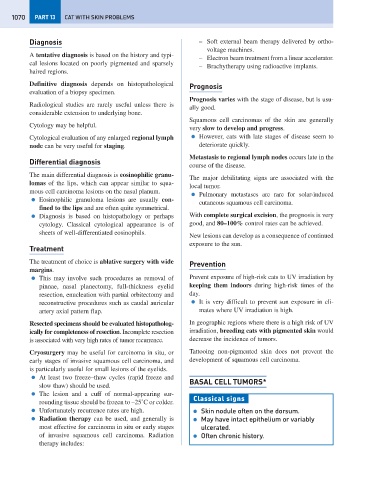Page 1078 - Problem-Based Feline Medicine
P. 1078
1070 PART 13 CAT WITH SKIN PROBLEMS
Diagnosis – Soft external beam therapy delivered by ortho-
voltage machines.
A tentative diagnosis is based on the history and typi-
– Electron beam treatment from a linear accelerator.
cal lesions located on poorly pigmented and sparsely
– Brachytherapy using radioactive implants.
haired regions.
Definitive diagnosis depends on histopathological Prognosis
evaluation of a biopsy specimen.
Prognosis varies with the stage of disease, but is usu-
Radiological studies are rarely useful unless there is
ally good.
considerable extension to underlying bone.
Squamous cell carcinomas of the skin are generally
Cytology may be helpful.
very slow to develop and progress.
Cytological evaluation of any enlarged regional lymph ● However, cats with late stages of disease seem to
node can be very useful for staging. deteriorate quickly.
Metastasis to regional lymph nodes occurs late in the
Differential diagnosis
course of the disease.
The main differential diagnosis is eosinophilic granu-
The major debilitating signs are associated with the
lomas of the lips, which can appear similar to squa-
local tumor.
mous cell carcinoma lesions on the nasal planum.
● Pulmonary metastases are rare for solar-induced
● Eosinophilic granuloma lesions are usually con-
cutaneous squamous cell carcinoma.
fined to the lips and are often quite symmetrical.
● Diagnosis is based on histopathology or perhaps With complete surgical excision, the prognosis is very
cytology. Classical cytological appearance is of good, and 80–100% control rates can be achieved.
sheets of well-differentiated eosinophils.
New lesions can develop as a consequence of continued
exposure to the sun.
Treatment
The treatment of choice is ablative surgery with wide Prevention
margins.
● This may involve such procedures as removal of Prevent exposure of high-risk cats to UV irradiation by
pinnae, nasal planectomy, full-thickness eyelid keeping them indoors during high-risk times of the
resection, enucleation with partial orbitectomy and day.
reconstructive procedures such as caudal auricular ● It is very difficult to prevent sun exposure in cli-
artery axial pattern flap. mates where UV irradiation is high.
Resected specimens should be evaluated histopatholog- In geographic regions where there is a high risk of UV
ically for completeness of resection. Incomplete resection irradiation, breeding cats with pigmented skin would
is associated with very high rates of tumor recurrence. decrease the incidence of tumors.
Cryosurgery may be useful for carcinoma in situ, or Tattooing non-pigmented skin does not prevent the
early stages of invasive squamous cell carcinoma, and development of squamous cell carcinoma.
is particularly useful for small lesions of the eyelids.
● At least two freeze–thaw cycles (rapid freeze and
BASAL CELL TUMORS*
slow thaw) should be used.
● The lesion and a cuff of normal-appearing sur-
Classical signs
rounding tissue should be frozen to –25˚C or colder.
● Unfortunately recurrence rates are high. ● Skin nodule often on the dorsum.
● Radiation therapy can be used, and generally is ● May have intact epithelium or variably
most effective for carcinoma in situ or early stages ulcerated.
of invasive squamous cell carcinoma. Radiation ● Often chronic history.
therapy includes:

